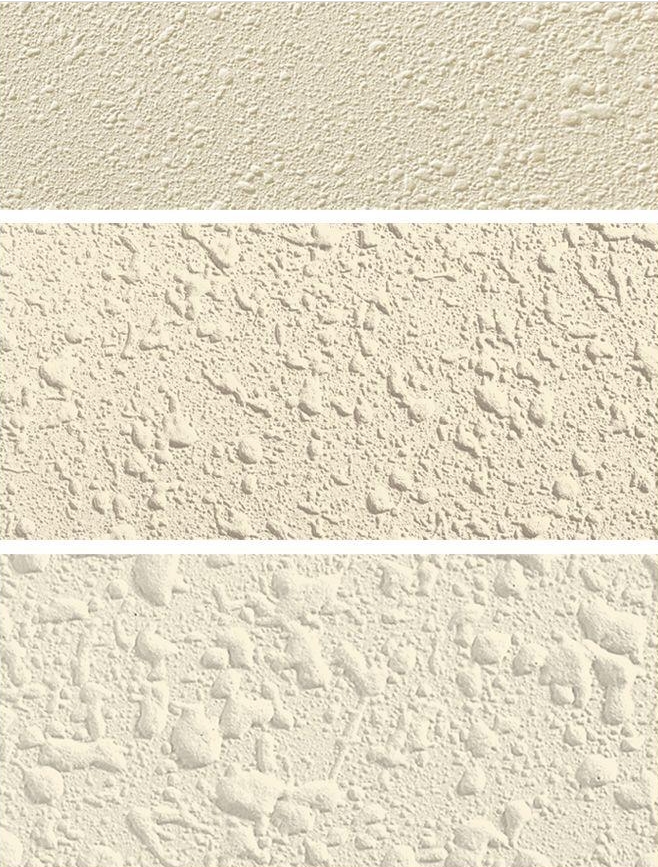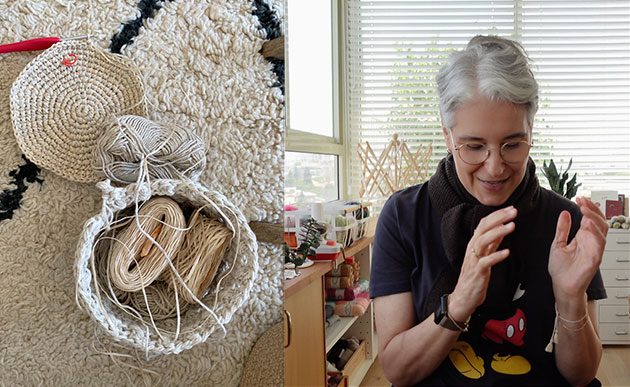With many wall texture types available, finding one that’s perfect for your living space can be a challenge.
Wall textures allow you to express your creativity, create depth, and aid in certain designs.
You can hire a drywall company to texture your wall or do it yourself. We’ll cover the many types of textured walls and how to get the look.
What Are The Different Wall Texture Types?
Drywall is the most common type of wall in the United States. If you don’t like the smoothness of drywall or need to mask imperfections, you can add texture over top of it. You can also add texture to plaster walls as long as they’re in good shape.
Popcorn Textured Walls

Popcorn ceilings have a bumpy, rigid texture. They were popular in the 60s and 70s thanks to their low cost and ability to hide imperfections. Popularity declined in the late 1980s when the EPA banned the use of asbestos. The original popcorn ceiling formula contained as much as 10% asbestos fibers.
How To Apply Popcorn Ceiling Wall Textures
To get a popcorn texture ceiling, you need popcorn ceiling spray or textured ceiling spray. Once you have your room prepped and the walls taped off, mix your spray with water according to the package instructions. Then, add the mix to your drywall texture sprayer and spray it onto the ceiling.
Orange Peel Wall Texture

Orange peel drywall looks like an orange peel. The tiny particles make it appear bumpy, but it still feels smooth. Orange peel can add texture to the wall in a more subtle way. Since orange peel hides imperfections, designers often use it in rental homes, commercial buildings, and on mediocre drywall work.
Orange Peel Technique
Orange peel texture is sprayed on a wall surface. It doesn’t contain rough particles of vermiculite or polystyrene, making it easy to work with. Many homeowners prefer it over popcorn. The goal for this wall texture is a splattered pattern that isn’t brushed and flattened.
Venetian Wall Textures

Venetian plaster is an ancient wall texture type that uses lime dust or marble dust with a classic stucco finish. The end result is a wall that looks like it’s made of marble. Venetian plaster is ideal for formal rooms and Renaissance-style homes.
How To Apply Venetian Wall Texture
You can use a trowel to apply Venetian plaster to your walls. Your first layer should be thin with straight lines. After the first coat is dry, apply another coat using your trowel in the opposite direction, creating an x-shaped pattern.
With the Venetian plaster dry, use sandpaper at a slight angle and circular motion to create a marble effect.
Knockdown Wall Textures

The knockdown drywall texture is a step above smooth walls and a step below orange peel walls. It has a mottled texture that adds dimension in a subtle way. The knockdown drywall pattern became popular in the 90s and is still in use today.
How To Apply Knockdown Wall Texture
To create a knockdown wall texture, you’ll need to mix an unaggregated joint compound with water. Then load the mixture in your drywall texture gun and splatter the walls. Finally, after the wall has had about 10 minutes to dry, work in sections, scraping a knockdown knife over the compound.
Slap Brush Knockdown Wall Textures

The slap brush style has a fan-like appearance and is also known as stipple texture. It looks similar to hand-plastered walls. It’s an ideal choice for covering imperfections in the wall and has a beginner-friendly application.
How to Apply Slap Brush Wall Texture
There are two methods to achieve a slap brush wall texture. For either method, you’ll need joint compound, water, and a slap brush. Mix the joint compound with water to thin it out. Then apply joint compound to the wall and stamp it with your slap brush. An alternate method is to dip the slap brush into the drywall mud and stamp it on the wall.
Slap Brush-Knockdown Wall Textures

The slap-brush knockdown style combines the stomping of the slap brush with a drywall knife for a “knocked down” pattern. The pattern of this wall texture is irregular and easy to DIY. You can even add a paint color to augment its style.
How To Apply Slap Brush-Knockdown Wall Texture
Mix joint compound with water and apply it to your wall. After 10 minutes, stamp the joint compound with a slap brush. Then, go over the wet compound with a knockdown trowel.
Sand Textured Wall

A sand texture is a gritty coating you can apply with a spray that uses sand and primer. You can create light and dark tones with this texture and choose the thickness of your sand grains.
How To Apply Sand Wall Texture
Mix sand with a watered-down primer or thin mud. Use a drywall texture gun to lightly spray the mixture on your wall. It works just like a popcorn ceiling, but it’s thinner and rarely cracks.
Sand Swirl

A sand swirl features raised circles or semi-circles. It’s an elegant texture and is common for ceilings.
How To Apply Sand Swirl Drywall Texture
To create a sand swirl drywall texture, add sand to thin drywall mud. Load the mixture into your hopper or drywall gun and spray the wall. Then use a thick-bristled brush to create your desired swirl pattern.
Comb Wall Texture

Drywall comb texture involves creating overlapping lines and swirls, thus creating a comb-like appearance.
While the technique creates different looks, arch patterns stacked on top of each other are the most common. During application, each line is alternated to create repeating patterns. This is known as the classic “comb texture” on drywall.
How To Apply Comb Drywall Texture
Apply drywall mud to the wall with a flat trowel. Then with a grooved trowel or brush, comb through the mud. Arches are the chosen pattern for this technique, but you can get creative. Depending on your skill level, this could be a fun DIY project.
Rosebud Wall Texturing

The rosebud texture looks similar to the slap brush texture but is more controlled. It is named after the rosebud and has a floral-like pattern. While this texture is common for ceilings, you can also use it on your walls.
How To Apply Rosebud Textured Walls
To apply rosebud wall texture, thin your drywall mud with water and apply it to the wall with a paint roller working in eight-foot sections. Then use a rosebud brush to stamp the wall. Repeat until the room is finished.
Lace Textured Walls
The lace drywall texture, also known as Spanish Lace, creates a stucco-like pattern that imitates old-fashioned lace. It’s most common on the interior walls of stucco homes.
How To Apply Lace Drywall Texture
Applying a lace texture involves spraying drywall mud on the wall and knocking it down with a drywall knife or skip trowel. It’s one of the more complicated DIY drywall textures and is best left to a professional.
Frequently Asked Questions (FAQ)FAQ
Which Of The Wall Texture Types Is Right For Me?
It depends on what you want. If you’re feeling bold and independent, try a rosebud technique. Maybe you want something simple and DIY, then go for a sand texture.
If you’re hiring a professional then it doesn’t matter what texture you choose. You can even come up with a new idea and they may be able to run with it. It never hurts to ask, so go bold and find your perfect wall texture.
How Do You Repair Textured Drywall Cracks?
When repairing textured drywall cracks, use plaster of paris to cover the cracks and fill in small holes. Make sure the plaster I s applied evenly. After you’re done, smooth the surface with a putty knife. To repair a one-inch hole, use a fiberglass patch that’s a little bigger so it covers the hole, and then stick the adhesive on the wall.
Do You Paint Drywall Before Texturing?
There’s no reason you should texture drywall. Texture is for when you want your wall to have a classic look or perhaps a contemporary look. It’s also done to cover flaws, not to make the paint work better as it offers long-lasting protection.
How Long Do I Wait For Wall Texture To Dry?
You need to wait 24 hours. When you open windows or use a box fan, it will speed up the drying process. After the mud is dry, prime and paint the surface would new drywall.
How Much Does It Cost To Tape And Texture Drywall?
The average cost of tape and mud drywall is between .35 to $1.10 per square foot. This price does not include sanding or the final finish to prime the surface for paint. Taping and mudding drywall joints for a standard 12 foot by 12-foot bedroom will cost between $180 to $580.
Do You Need To Prime Drywall Before Texture?
Yes, you should prime your walls before you texture them with a latex drywall primer. You’ll also need to make sure that you don’t use undercoater as the walls will have too much of a sheen. This would ruin the classic look that you want your end result to achieve.






